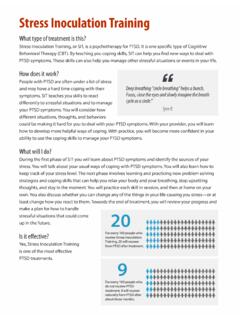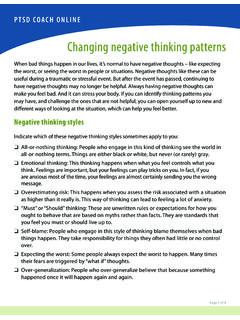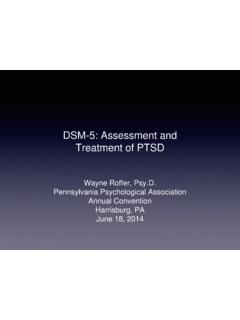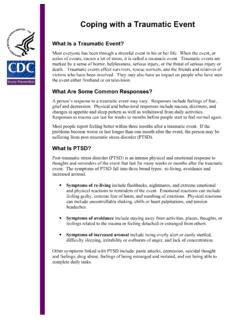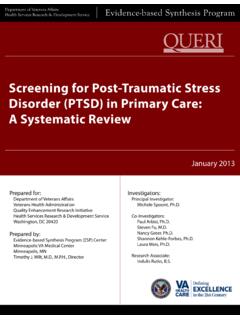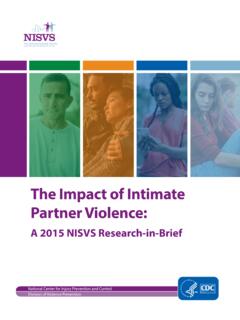Transcription of Group Treatment for PTSD - PTSD: National Center for …
1 Research Quarterlyadvancing science and promoting understanding of traumatic stressGroup Treatment for PTSDD enise M. SloanVA National Center for ptsd , VA Boston Healthcare System, and Boston University School of MedicineJ. Gayle BeckThe University of MemphisDespite the rich history of Group treatments for ptsd , there is a surprising lack of methodologically rigorous studies in this domain. We know that at one point, rap groups were seen to be the Treatment of choice for Vietnam Veterans (Foy et al., 2000) and support groups still play a significant role in many agencies that serve trauma survivors, including Department of Veterans Affairs (VA) settings (Hundt, Robinson, Arney, Stanley, & Cully, 2015). Despite the popularity of support groups for trauma survivors, the Group Treatment research literature is characterized by open trial ( , Ready et al.)
2 , 2008) or non-randomized designs ( , Resick & Schnicke, 1992), which are helpful in the beginning stages of Treatment development. However, the number of randomized clinical trials (RCT) is limited. Consequently, there are currently no Group treatments for ptsd recognized as evidence-based ( , VA & Department of Defense [DoD], 2010). In this article, we will summarize the current knowledge about Group treatments for ptsd and highlight areas that deserve greater empirical focus. Sloan, Feinstein, Gallagher, Beck, and Keane (2013) conducted a meta-analysis of RCTs of Group Treatment studies for ptsd . Studies were excluded if individual and Group components were mixed within a protocol, resulting in 16 studies, with a total of 1,686 participants. Most of these treatments were cognitive behavioral, however, the content of these protocols varied considerably.
3 Group Treatment was found to have superior Treatment outcome effects relative to wait list (WL). However, no significant differences were observed for cognitive behavioral Group interventions relative to other active treatments ( , present centered Treatment ). Moderator analyses revealed smaller effect sizes for males relative to females and military-related and childhood trauma relative to mixed trauma samples. These findings should be interpreted with caution, given the small number of studies. Another important observation is that each of the 16 studies examined a different Group Treatment . Authors Addresses: Denise M. Sloan PhD is affiliated with the National Center for ptsd (116B-2), VA Boston Healthcare System, 150 South Huntington Avenue, Boston, MA 02130 and the Boston University School of Medicine, 72 E Concord St, Boston, MA 02118.
4 J. Gayle Beck, PhD is affiliated with the Department of Psychology, University at Memphis, Psychology Building, Memphis, TN 38152-3230. Email Addresses: and The current article is supported by Department of Veteran Affairs Merit award (I01 CX000467) awarded to the first author and funds associated with the Lillian and Morrie Moss Chair of Excellence, held by the second on page 2 Since this meta-analysis was published, only a handful of additional RCT Group trials for ptsd have been published ( , Bass et al., 2013; Castillo et al., 2016; Morland et al., 2014; Resick et al., 2015). Clearly, this is an area ripe for needed study. Trauma-focused Group Treatment for PTSDA lthough the advancement of Group Treatment for ptsd has been limited by the lack of RCTs, there are a number of protocols that have promise and deserve further investigation.
5 Examining Group formats of currently available first-line individual ptsd Treatment approaches (VA & DoD, 2010), such as Cognitive Processing Therapy (CPT) and Prolonged Exposure (PE), is one obvious path to pursue. In fact, the first efficacy study of Cognitive Processing Therapy (CPT) used a Group format of the Treatment (Resick & Schnicke, 1992). Several additional studies have been conducted with CPT administered in Group format, with variations including a cognitive only version of CPT, referred to as CPT-cognitive only (CPT-C; Morland et al., 2014; Resick et al., 2015), Group CPT-C modified for cultural considerations (Bass et al., 2013), and a combined individual and Group format of CPT (Chard, 2005). Most recently, Resick and colleagues investigated the CPT-C Group format relative to Group present centered therapy (PCT) with a cohort of active duty service men and women diagnosed with military-related ptsd .
6 Both Group treatments consisted of 12, 90 minute sessions. Findings indicated significant reductions in ptsd severity for both conditions. A significant reduction was also observed for depression in the CPT-C only. Without inclusion of a no- Treatment comparison, it is unknown whether significant reductions in ptsd are the result of Treatment or other factors such as the passage of time or nonspecific Group support. Published by: National Center for ptsd VA Medical Center (116D) 215 North Main Street White River Junction Vermont 05009-0001 USA(802) 296-5132 FAX (802) 296-5135 Email: issues of the ptsd Research Quarterly are available online at: Editorial Members: Editorial Director Matthew J. Friedman, MD, PhDBibliographic Editor Misty Carrillo, MLISM anaging Editor Heather Smith, BA Ed National Center Divisions: Executive White River Jct VTBehavioral Science Boston MADissemination and Training Menlo Park CAClinical Neurosciences West Haven CTEvaluation West Haven CT Pacific Islands Honolulu HI Women s Health Sciences Boston MAVOLUME 27/NO.
7 2 ISSN: 1050-1835 2016 PAGE 2 ptsd RESEARCH QUARTERLYC ontinued from coverIt should be noted that the Group format of PCT has been found to be a moderately efficacious Treatment in several Group trial studies (Classen et al., 2011; Schnurr et al., 2003) and superior to a no Treatment comparison condition (Classen et al., 2011). Thus, the limited number of studies using Group formats of the first line ptsd treatments, combined with a lack of a no Treatment comparison, limits interpretation of the Resick et al. (2015) (2005) used a different approach to delivering CPT in a Group format. In a study of women survivors of childhood sexual assault, Chard adapted the CPT protocol to include 27 sessions of Group (17) and individual (9) sessions. Individual sessions were devoted tospecifics of the individual event, including the trauma impact statementand trauma narratives.
8 Group sessions were used to reinforce skillsand concepts introduced in the individual sessions and to foster socialbonds with other Group members. Findings indicated significantlygreater reductions of ptsd symptoms for the adapted CPT conditionrelative to a minimal attention (MA) comparison condition. Moreover, Treatment gains for the adapted CPT condition were maintained ata one year follow-up. Given the various formats of Group CPT thathave been investigated, it is unclear at this time which format is thebest to pursue for additional there is a large literature demonstrating the efficacy and effectiveness of Prolonged Exposure (PE) therapy, there are no current studies investigating a Group format of PE. Exposure is thought to be a critical component to effective ptsd Treatment ( , Institute of Medicine, 2008), so inclusion of exposure within Group Treatment for ptsd is important.
9 There is debate, however, about whether conducting trauma exposure within the Group setting (rather than individually) is problematic, owing to vicarious traumatization of other members. There have been a number of Group protocols that have used various approaches to conducting imaginal and/or in vivo exposures in the context of Treatment . For example, Schnurr et al. (2003) examined the efficacy of a trauma-focused Group Treatment (TFGT) compared to Group PCT for military-related ptsd . Both Treatment conditions involved 30 weekly sessions lasting 90 minutes, although sessions that included exposure lasted two hours. Imaginal exposure was conducted within the Group by Veterans taking turns recounting their trauma event while other members listened. Each Veteran had two sessions devoted to recounting their trauma event, with imaginal exposure sessions starting in session 9 through session 22.
10 In vivo exposure was not included in the protocol. The time needed to conduct imaginal exposure within the Group for each Group member was extensive and may reduce the potential cost-effectiveness of the Group format. Schnurr et al. attempted to make up for the limited time for in-session exposure through daily homework utilizing audiotapes. Findings indicated both groups had significant reductions in ptsd symptoms, with no between Treatment differences. Significant between Treatment differences were only observed for participants who completed Treatment , with significantly greater reductions in TFGT relative to Group PCT. Notably, Treatment dropout was substantially higher in the TFGT (23%) relative to Group PCT (9%). Although information was not collected regarding reasons for dropout, participants may have found exposures conducted in-session difficult to and colleagues (2008) also conducted exposure in-session by adapting the approach used by Schnurr et al.


